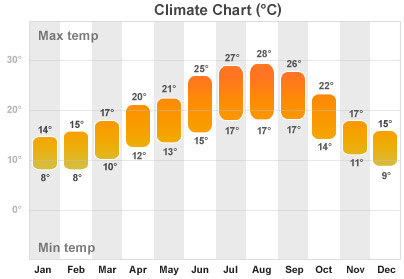Lisbon climate is a Subtropical-Mediterranean type with pretty warm summers and mild winters. The strong influence of Gulf Stream has gifted it one of the most pleasant climates of Europe. With a mean temperature of over 15.2 ˚C in the daytime and about 8.9˚C at night, it experiences the warmest winters of Europe from December all the way to February. Frost, snow, etc. are alien items. The May to October period forms the 6 months of summer with mean temperature of about 25˚C in the daytime and 16˚C at night. Sometimes, the months of April, March and November experience temperature of over 20˚C with a mean temperature of about 18.5˚C in the daytime and 11.2˚C at night. Generally, summers are dry with rainfall taking place primarily in winter.  Due to the high proximity to the majestic Atlantic Ocean, breezy and unpredictably fickle weather is a common thing in Lisbon. You never know when you will need an umbrella and when a jacket, especially in autumn, winter and spring. With latitudes and longitudes 38°42′49.75″N and 9°8′21.79″W respectively, running through it, Lisbon falls right at the mouth of River Tagus. It occupies 84.8km2 of area and unlike most of the major cities it has its city limits narrowly marked out by the historic center. The remaining urban area, generically called Lisbon is in reality administratively divided into numerous cities like Cacem, Queluz, Barreiro, Amadora, Odivelas, etc. and another large unit forming a portion of Lisbon Metropolitan Area. The terrain of Lisbon gradually rises, as you move away from the ocean, northwards. No wonder, there are so many steep roads and staircases. The Monsanto Forest Park occupies the western region. The main street, to the north of Baixa, called Avenida da Liberdade is an avenue lined with leafy trees, beautiful hotels and top notch shops with Praca de Pombal terminating it. The east has the Alfama and Mouraria surviving from the Moors era while the west hosts steep rising hills.
Due to the high proximity to the majestic Atlantic Ocean, breezy and unpredictably fickle weather is a common thing in Lisbon. You never know when you will need an umbrella and when a jacket, especially in autumn, winter and spring. With latitudes and longitudes 38°42′49.75″N and 9°8′21.79″W respectively, running through it, Lisbon falls right at the mouth of River Tagus. It occupies 84.8km2 of area and unlike most of the major cities it has its city limits narrowly marked out by the historic center. The remaining urban area, generically called Lisbon is in reality administratively divided into numerous cities like Cacem, Queluz, Barreiro, Amadora, Odivelas, etc. and another large unit forming a portion of Lisbon Metropolitan Area. The terrain of Lisbon gradually rises, as you move away from the ocean, northwards. No wonder, there are so many steep roads and staircases. The Monsanto Forest Park occupies the western region. The main street, to the north of Baixa, called Avenida da Liberdade is an avenue lined with leafy trees, beautiful hotels and top notch shops with Praca de Pombal terminating it. The east has the Alfama and Mouraria surviving from the Moors era while the west hosts steep rising hills.
© Copyright 2014. Travelvivi magazine


